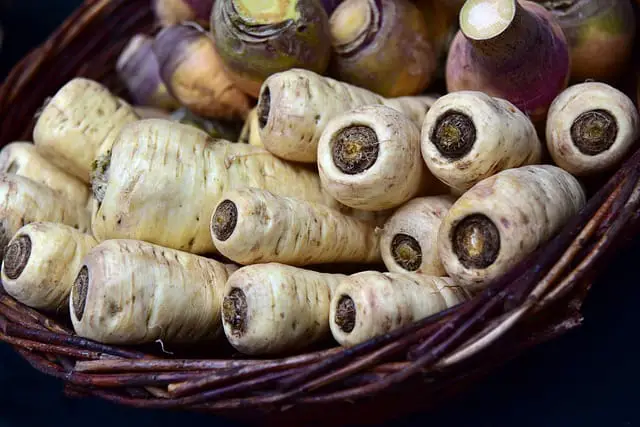Ever got curious as to how a white radish compares to a parsnip — because they both look similar?
Are they from the same family? Or a closely related family? Do they share a similar nutritional profile?
This article takes a deep dive into the similarities and differences between a white radish and parsnip using important categories such as classification, appearance, affordability, nutrients, taste, texture and overall culinary use.

| s/n | Category | White Radish | Parsnip |
| 1 | Classification | Root tuber, but belongs to the cabbage family. | Root tuber, but belongs to the parsley family |
| 2 | Color | White colored skin and flesh, although non white varieties exist such as the watermelon radish having green exterior and a rose interior and the Korean radish having a two tone color of white and green on the skin with a white interior. | Cream colored flesh and skin. |
| 3 | Shape | Typically long, cylindrical but can be oblong or oval. | Tapered |
| 4 | Taste | Lightly spicy with sweet undertone. | Sweet, peppery undertone. |
| 5 | Affordability | More expensive, although just slightly costly | Cheaper |
| 7 | Texture | Strong, Crisp | Strong, Crisp |
| 8 | Calories (per 100g) | 18 kclal | 75 kcal |
A more thorough breakdown
This section reviews the entire categories (of the table) one after the other in order to really get into the depths of how a white radish differs from a parsnip.
Classification
When it comes to classification, both white radish and parsnips belong to different families. White radish belongs to the cabbage family — the reason why it exudes a kind of sulfuric smell whenever you store it or make pickles with it, whereas parsnip belongs to the parsley or carrot family — hence its sweet flavor.
Some of the most notable members of the parsley family include celery, parsley, dill, coriander, and caraway. On the other hand, the cabbage family includes notable members like cabbage itself, mustards, kill, broccoli and collards.
Appearance
In terms of appearance, parsnip is structured somewhat like a carrot, except that it comes in various cream hues. White radish has a root that ranges from long, narrow or tapered to spherical depending on the variety.
The roots of the white radish can be entirely white, or in the case of watermelon radish, be green on the outside with a rose colored interior. Other variations like the Korean radish also have a two-tone skin color of green and white.
Taste
For taste, there is a big contrast to observe between the two vegetables.
The white radish has a mild flavor with peppery undertones, whereas the parsnip has a nutty sweet flavor with just slight pepperiness.
The sweetness of parsnip typically increases with cooking whereas the spiciness of radish mellows down more.
Affordability
Parsnip is much more affordable and available than white radish.
Nutrients
In terms of nutritional composition, parsnip does have the upper hand as it is loaded with more percentages of vitamins and minerals compared to the white radish.
In terms of calorie, parsnip offers about 75 kcal for every 100 g of the produce, whereas white radish offers only 18 kcal.
Parsnip also has about 4 times more carbohydrates per hundred grams of produce than white radish. It also contains double the amount of fat and protein although the total protein content of both produce is pretty small when you realize that the average human requires about 0.8 g per kilogram of body weight per day and both parsnip and white radish supply only 0.2 g and 0.1 g respectively.
Then comes minerals and vitamins. In this category also, parsnips has more of the soluble vitamins except for vitamin C where the white radish takes the upper hand by supplying 27% of the daily recommended value for an adult compared to the parsnips 20%.
Parsnip also supplies a heavy amount of vitamin E and K at 10% and 20% of the daily recommended value.
Overall, parsnips has more percentages of minerals than white radish. Both have minerals like phosphorus, magnesium and manganese.
And finally, when it comes to water content, the white radish has more of it when compared to parsnip. White radish is made up of 95% water whereas white radish is made up of 79% water.
All in all, we can easily see that parsnip is the more nutritious of the two vegetables.
Texture
Both parsnip and white radish have a crispy texture that softens with the application of heat.
Use
Both root vegetables have an immense culinary application. Both can be roasted, stir fried, sauteed, used in soups, or used to make their own soups and stews, boiled, braised, and even cut finely into salads.
Health effects
Parsnip is a reliable source of vitamin K, E, C, and it is also a good source of Magnus. All of these have scientifically proven health benefits of their own.
Both root vegetables are packed with antioxidants. They can help decrease the damage to sauce, as well as protect against diseases, such as cancer and heart disease.
Both vegetables also aid with weight loss because they contain fiber that gives the feeling of fullness and also because they both have very low calories overall.
The vitamin C content in both vegetables supports the production of collagen which is excellent for healthy skin.
Radishes also have an antifungal protein called RsAFP2 which can help protect against fungal infections.
Side effects
Allergic reactions from consuming both parsnip and white radishes are rarely reported, although they can still happen.
The majority of the population will be able to consume both root vegetables without running into any problems.
